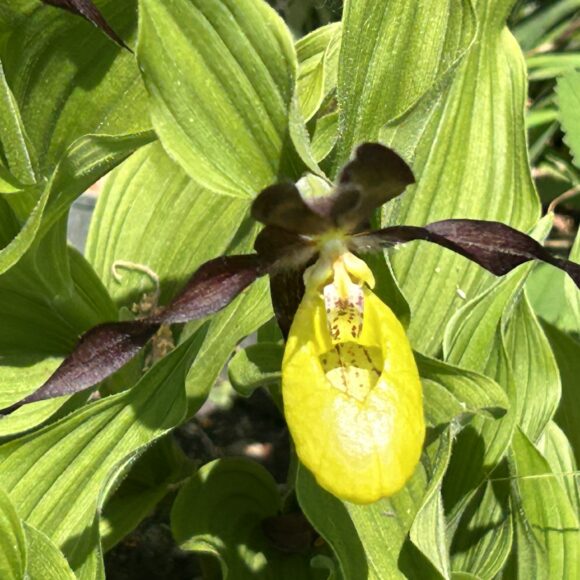
Look Wild: Protecting Orchids of the Dales
-
Date posted: 29/06/2023
-
Time to read: 6 minutes

Lady’s-slipper Orchid
The Yorkshire Dales National Park is home to nationally and internationally important landscapes and wildlife. Our 17 priority habitats include the species-rich hay meadows of the valley bottoms, the calcareous grasslands on the thin limestone soils, the upland ash and oak woodlands on the valley sides, and the fell top blanket bog and heathland. In the Dales we have more than 120 species which are national priorities for conservation action, including one of the rarest plants in the UK, the Lady’s-slipper orchid.
The Lady’s-slipper orchid is a very striking and special plant that grows up to 30cm tall. It can take up to ten years before flowering and, when it does, it produces just a single flower per plant, which appears in May or June.
It is the flower’s characteristic yellow slipper-shaped pouch that gives this species its name. These pouches attract bees which, once inside, can only get out through the narrow opening where they either collect or deposit pollen.
The species was once widespread and relatively common across the limestone areas of the Yorkshire Dales National Park. In fact, records from the late 1790s suggest that bundles of the flowers were sold on market stalls in Settle. But today the plant is perhaps the rarest species in the UK, with just one wild site in the country, which is here in the Yorkshire Dales National Park. Because of its rarity, its location is undisclosed and protected to ensure that the orchid is not taken, as the illegal collection of wild orchids is still a problem.
Work has been undertaken to try and improve the fortunes of this species. Seeds have been successfully micro-propagated at the Royal Botanical Gardens at Kew, and seedlings of the lady’s-slipper orchid have been reintroduced to a number of sites where it is now flowering.
In June, all 15 UK National Parks took part in a volunteering day focused on priority habitats and species and learning more about them. Up and down the country members of the public joined National Park Authority staff and other volunteers to conserve and enhance special places as part of the Look Wild Project. This project encourages people to record and learn about the nature around them at home and also when out and about in National Parks.
In the Yorkshire Dales our volunteering day saw members of the public meet at Kilnsey Park Estate in Wharfedale, one of the sites where the lady’s-slipper orchid has been re-introduced. They joined National Park Authority staff, Dales Volunteers and estate owner Jamie Roberts to help clear ground in order to conserve the habitat for the orchids. They also heard from Stella Hughes from Upper Wharefdale Field Society about the special qualities of Kilnsey Flush nature reserve, the importance of the orchids of the Dales and the incredible tale of decline and recovery of the lady’s-slipper orchid.

Kilnsey Park welcomes visitors to visit their nature reserve, visit their website for more information. You can also find more about the work of the Upper Wharfedale Field Society on their website.